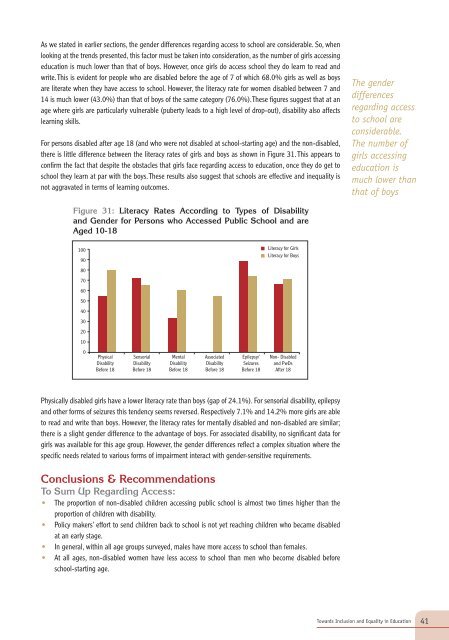Handicap International experience in Afghanistan - CBM
Handicap International experience in Afghanistan - CBM
Handicap International experience in Afghanistan - CBM
- No tags were found...
Create successful ePaper yourself
Turn your PDF publications into a flip-book with our unique Google optimized e-Paper software.
As we stated <strong>in</strong> earlier sections, the gender differences regard<strong>in</strong>g access to school are considerable. So, whenlook<strong>in</strong>g at the trends presented, this factor must be taken <strong>in</strong>to consideration, as the number of girls access<strong>in</strong>geducation is much lower than that of boys. However, once girls do access school they do learn to read andwrite. This is evident for people who are disabled before the age of 7 of which 68.0% girls as well as boysare literate when they have access to school. However, the literacy rate for women disabled between 7 and14 is much lower (43.0%) than that of boys of the same category (76.0%). These figures suggest that at anage where girls are particularly vulnerable (puberty leads to a high level of drop-out), disability also affectslearn<strong>in</strong>g skills.For persons disabled after age 18 (and who were not disabled at school-start<strong>in</strong>g age) and the non-disabled,there is little difference between the literacy rates of girls and boys as shown <strong>in</strong> Figure 31. This appears toconfirm the fact that despite the obstacles that girls face regard<strong>in</strong>g access to education, once they do get toschool they learn at par with the boys. These results also suggest that schools are effective and <strong>in</strong>equality isnot aggravated <strong>in</strong> terms of learn<strong>in</strong>g outcomes.The genderdifferencesregard<strong>in</strong>g accessto school areconsiderable.The number ofgirls access<strong>in</strong>geducation ismuch lower thanthat of boysFigure 31: Literacy Rates Accord<strong>in</strong>g to Types of Disabilityand Gender for Persons who Accessed Public School and areAged 10-1810090• Literacy for Girls• Literacy for Boys80706050403020100PhysicalDisabilityBefore 18SensorialDisabilityBefore 18MentalDisabilityBefore 18AssociatedDisabilityBefore 18Epilepsy/SeizuresBefore 18Non- Disabledand PwDsAfter 18Physically disabled girls have a lower literacy rate than boys (gap of 24.1%). For sensorial disability, epilepsyand other forms of seizures this tendency seems reversed. Respectively 7.1% and 14.2% more girls are ableto read and write than boys. However, the literacy rates for mentally disabled and non-disabled are similar;there is a slight gender difference to the advantage of boys. For associated disability, no significant data forgirls was available for this age group. However, the gender differences reflect a complex situation where thespecific needs related to various forms of impairment <strong>in</strong>teract with gender-sensitive requirements.Conclusions & RecommendationsTo Sum Up Regard<strong>in</strong>g Access:• The proportion of non-disabled children access<strong>in</strong>g public school is almost two times higher than theproportion of children with disability.• Policy makers’ effort to send children back to school is not yet reach<strong>in</strong>g children who became disabledat an early stage.• In general, with<strong>in</strong> all age groups surveyed, males have more access to school than females.• At all ages, non-disabled women have less access to school than men who become disabled beforeschool-start<strong>in</strong>g age.Towards Inclusion and Equality <strong>in</strong> Education41
















